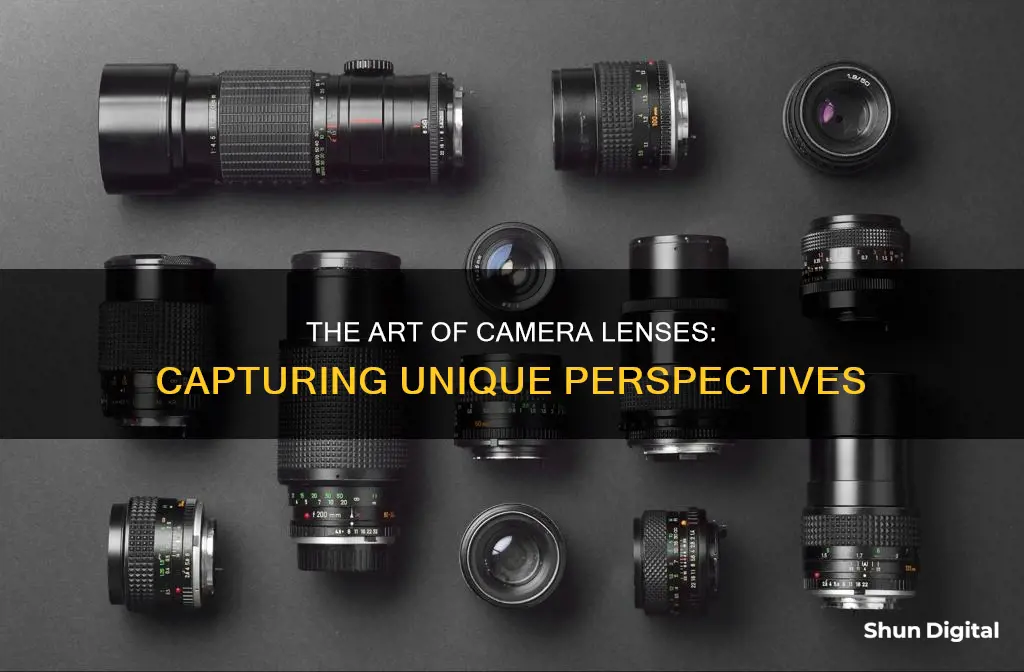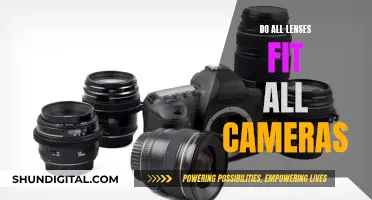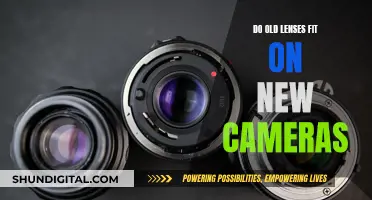
Camera lenses are an essential part of photography. They are an optical body that features a single lens or an assembly of lenses that mounts to a camera body. They focus light onto the camera's image sensor or film, allowing the camera to capture images. The lens controls aspects like framing, perspective, depth of field, and the light entering the camera.
The quality of the lens is important as it determines how much detail an image can contain. A high-quality lens can help capture great photos even with a cheap camera, while a low-quality lens can make the best camera mediocre.
Lenses have different focal lengths, which determine the field of view and how much of the subject will be in focus. Lenses also have different apertures, which control how much light enters the lens.
There are two main types of camera lenses: zoom lenses and prime lenses. Zoom lenses have variable focal lengths, allowing photographers to zoom in and out. Prime lenses, on the other hand, have fixed focal lengths, meaning the photographer cannot zoom in or out.
| Characteristics | Values |
|---|---|
| Purpose | To focus and direct light onto the camera's image sensor or film |
| Use | To capture images by controlling aspects like framing, perspective, depth of field, and the light entering the camera |
| Functionality | Interchangeable lenses with different focal lengths, apertures, and other properties |
| Focal Length | Determines the field of view and magnification of the image |
| Aperture | Controls how much light enters the lens |
| Depth of Field | Determines how much space in front of the camera is in focus |
What You'll Learn

Camera lenses focus light onto the image sensor or film
Camera lenses are an essential part of photography. They are what allow a camera to capture images. Without a lens, a camera is useless to a photographer. The lens is what focuses light from what you see through the viewfinder into a tiny spot on the back of your film, DSLR, or mirrorless camera.
A camera lens is an optical body that features a single lens or an assembly of lenses that mounts to a camera body. Lenses are made up of several "lens elements", with each element directing the path of light rays to recreate the image as accurately as possible on the digital sensor. The goal is to minimise aberrations while still using the fewest and least expensive elements.
The front element of a lens is the foremost piece of glass that faces the subject. Its primary function is to protect the inner lens elements and bend or refract light as it enters the lens. The rear element is the last piece of glass within the lens, positioned closest to the camera sensor or film. Its role is to help focus the light gathered by the lens elements onto the sensor or film plane.
The lens aperture is an adjustable opening within the lens that controls the amount of light passing through. It is composed of multiple blades that can contract or expand to change the size of the opening. The aperture size affects the depth of field (the range of sharp focus) and the image's exposure.
The focal length of a lens is the distance between the point of convergence and the image sensor. It determines the field of view and thus how much the subject will be magnified for a given photographic position. Wide-angle lenses have short focal lengths, while telephoto lenses have longer corresponding focal lengths.
The Evolution of Camera Lenses: Losing Sharpness Over Time?
You may want to see also

They control the aperture, depth of field, and framing
Camera lenses are an essential component of photography, working in tandem with the camera body to capture images. They serve multiple purposes, including controlling the aperture, depth of field, and framing.
Aperture Control
The aperture refers to the opening within the camera lens that allows light to pass through and reach the image sensor. This mechanism is similar to the iris in the human eye, which expands or shrinks to adjust the size of the pupil and control the amount of light entering the eye. By adjusting the aperture, photographers can control the amount of light that reaches the camera sensor, thereby influencing the brightness or exposure of the image.
Depth of Field
In addition to controlling light, the aperture plays a crucial role in determining the depth of field in a photograph. The depth of field refers to the distance between the nearest and farthest objects in a scene that appear sharp and in focus. A larger aperture results in a shallower depth of field, creating a beautiful blurred background effect often desired in portrait photography. Conversely, a smaller aperture yields a wider depth of field, keeping both the foreground and background sharp, which is commonly used in landscape photography.
Framing and Angle of View
Camera lenses also influence the framing and angle of view of a photograph. Different lenses offer varying focal lengths, which determine the magnification of the image and the angle of view. Wide-angle lenses provide a wider field of view, while long-focus lenses, such as telephoto lenses, offer a narrower angle of view. The choice of lens and its focal length directly impact the framing of the subject and the overall composition of the image.
In summary, camera lenses are instrumental in shaping the final image by controlling the aperture, depth of field, and framing. They are a crucial tool for photographers to master, allowing them to capture images with specific effects, lighting, and compositions.
The Evolution of Camera Lenses: From Bulky to Compact
You may want to see also

Lenses are more important than the camera body
Camera lenses are an essential component of photography, working in conjunction with the camera body to capture images. Lenses are responsible for focusing light onto the camera's film, digital sensor, or mirrorless system, ultimately determining image quality. While the camera body plays a crucial role in capturing light, the lens's quality and specifications will have a more significant impact on the final image.
The lens' focal length, aperture, and optical elements are key factors in its performance. Focal length determines the angle of view and magnification, with wide-angle lenses offering shorter focal lengths and telephoto lenses longer ones. The aperture, or f-stop, controls the amount of light entering the lens, influencing exposure and depth of field. Lenses with more optical elements can reduce optical aberrations, improving image sharpness, contrast, and colour accuracy.
When comparing the importance of the camera body and lens, it's essential to understand their interdependence. The camera body's capabilities, such as autofocus and low-light performance, are crucial. However, the lens ultimately defines the shot's focal length, depth of field, and image quality. A high-quality lens can elevate the performance of a basic camera body, while a poor-quality lens can hinder the results of an advanced camera.
Investing in a good lens is often a wiser decision than solely focusing on the camera body. A versatile lens with a wide aperture, sharp optics, and a suitable focal length range can significantly enhance your photography. It can provide creative control, allowing you to capture a variety of compositions and perspectives, which is especially beneficial for dynamic subjects and low-light conditions.
In conclusion, while both the camera body and lens are essential, investing in a high-quality lens will often yield better results. The lens has a more direct impact on image quality and provides more opportunities for creative expression. Therefore, lenses are indeed more important than the camera body when it comes to capturing exceptional photographs.
The Mystery of Sandpapering Camera Lenses: What's the Outcome?
You may want to see also

The focal length determines the field of view
The focal length of a camera lens is the distance between the point of convergence and the image sensor. This distance is measured in millimetres and determines the field of view, or angle of view, of the lens. The point of convergence is where light rays travelling through the lens meet. The closer the point of convergence is to the image sensor, the smaller the object appears.
A lens with a short focal length has a wide field of view and is known as a wide-angle lens. Conversely, a lens with a long focal length has a narrow field of view and is known as a telephoto lens.
The focal length also determines the magnification of the image. A shorter focal length results in a smaller image, while a longer focal length results in a larger image.
Different types of photography require different focal lengths. For example, a wide-angle lens is typically used for landscape photography, while a telephoto lens is often used for wildlife photography.
The focal length of a lens also affects the perspective of an image. Using a wide-angle lens can exaggerate or stretch the perspective, while a telephoto lens can compress or flatten it.
Understanding Camera Lenses: Classification and Functionality
You may want to see also

Zoom lenses are more versatile but prime lenses produce higher-quality images
Camera lenses are an essential component of photography, as they are responsible for focusing light into the camera and onto the image sensor, which is how an image is produced. The lens you choose can have a significant impact on the final image, and there are many factors to consider when selecting one, such as cost, size, weight, lens speed, and image quality.
Two types of lenses that you may consider are zoom lenses and prime lenses. Zoom lenses offer more versatility as they allow you to adjust the focal length, giving you a range of different perspectives without having to change your position. This makes them a good choice for dynamic subjects or situations where you need to adapt quickly, such as photojournalism or children's photography.
On the other hand, prime lenses have a fixed focal length, meaning you cannot zoom in or out. While this may seem like a limitation, prime lenses offer several advantages. They generally provide better image quality than zoom lenses, especially in low-light conditions, as they typically have a wider maximum aperture, allowing more light to reach the image sensor. This makes them ideal for situations where you need excellent low-light performance, such as sports or theatre photography. Additionally, prime lenses tend to be more compact, lightweight, and more affordable than zoom lenses.
In summary, while zoom lenses offer the convenience of adjustable focal lengths, prime lenses excel in image quality, especially in low-light conditions, and are often more lightweight and cost-effective. The best choice for you will depend on your specific needs and preferences as a photographer.
Smartphone Camera Lenses: Full-Frame Equivalents Explained
You may want to see also
Frequently asked questions
A camera lens is an optical body that features a single lens or an assembly of lenses that mounts to a camera body. Camera lenses can be interchangeable or built into the construction of the camera itself.
Camera lenses are essential for capturing images. They focus and direct light onto the camera's image sensor or film, and allow you to control aspects like framing, perspective, depth of field, and the light entering the camera.
Zoom lenses have variable focal lengths, meaning you can zoom in and out. Prime lenses have a fixed focal length, so you can't zoom in or out.
Full-frame sensors are the same size as 35mm film cameras (36 x 24mm). Crop sensors are smaller, with the most common sizes being APS-C (25.1 x 16.7mm) and Micro Four Thirds (18 x 13.5mm).
Different types of lenses offer different focal lengths, which determine the field of view and magnification. Wide-angle lenses have short focal lengths, capturing a wider image, while telephoto lenses have longer focal lengths, capturing a narrower, more magnified image.







